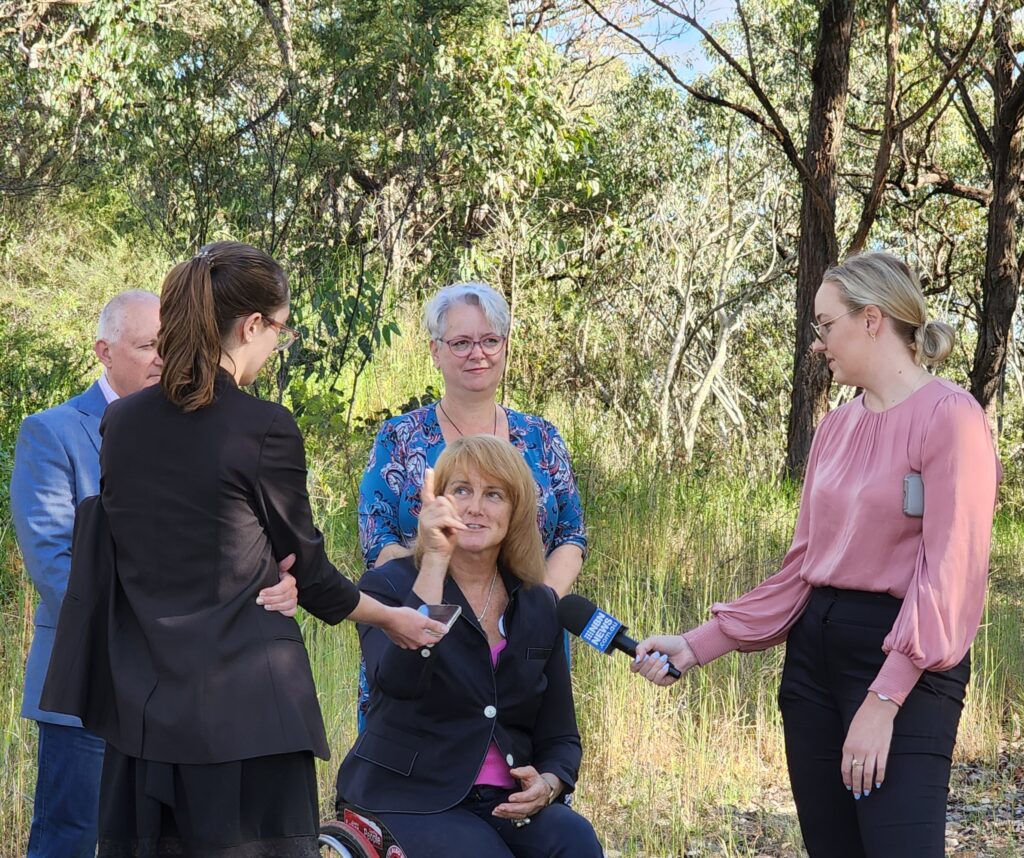Three NSW Supreme Court Judges have thrown out an appeal by Verde Terra Pty Ltd, proponents of the Mangrove Mountain Landfill. Here’s our interpretation of what the judgement means and its consequences for the future of the landfill.

By Jacquelene Pearson
Judges Ward P, White JA and Kirk JA determined to dismiss Verde Terra’s appeal with costs on 2 June 2023.
This is a long and torturous saga that started back in 1998 (or even 1991 according to the appeal judges) when there was a decision made to import 240,000 cubic metres of clean fill onto land adjacent to the Mangrove Mountain Memorial Club which was excavated to accommodate the waste. The idea was to remodel and upgrade the golf course, taking it from nine to 18 holes.
The then Gosford City Council approved the development.
All was well for a couple of years. Gosford Council approved amendments to the conditions of consent in 2003 and 2009 but, over time, it became apparent that the volume and nature of the waste at the site appeared to breach the conditions of consent granted by Gosford Council. Meanwhile, the NSW Environmental Protection Authority (EPA) granted an environmental protection license (EPL) to the project in 2001 to allow the import of general waste. The EPA continued to grant amendments to the EPL without the knowledge of the council.
By 2012 the matter was before the Land and Environment Court as the volume of waste found at the site had grown to 900,000 cubic metres of mixed waste in unlined cells. Community concerns about leachate from the landfill making its way into ground and surface water became acute.
The outcome of that Land and Environment Court action was a behind-closed-doors mediation resulting in Court Orders. However, instead of reducing the amount of waste at the site, Gosford City Council agreed to further dumping.
From 2014 to 2019 concerted campaigns by the Mountain Districts Association and the Mangrove Mountain and Districts Community Association kept the site idle but concerns about leachate and other environmental impacts continued.
Verde Terra lodged a new development application in December 2018 “described as a development of a regional landfill”. Central Coast Council failed to respond to the DA within the statutory timeframe, so it was a deemed refusal.
Meanwhile, largely due to community pressure, the EPA refused to allow any more license variations until the matter of consent between Verde Terra and Central Coast Council was decided.
Verde Terra took the case back to the Land and Environment Court in 2019 as a result of the deemed refusal of its DA.
Verde Terra wanted the LEC to find that it did not “need further development consent to carry out the development of the landfill and golf course”. It also wanted the court to declare “that the landfill and golf course constituted an ‘existing or approved’ development.
In her March 2022 decision, Pepper J found in favour of Verde Terra on the first matter but “declined to make the second” declaration. Verde Terra had argued that Pepper not making the second declaration didn’t have any practical bearing because their proposal “did not increase the total environmental impacts of the development the subject of the 2014 orders”.
This ruling left Verde Terra in limbo so they appealed, and it is the judgement from that appeal that is now being considered by Verde Terra, Central Coast Council and the EPA.
The latest judgement
In this latest, and likely the last, judgement, it was found that the development in its current form has not been approved. The judges examined the 2014 settlement and court orders that were the outcome of breaches of the original 1998 development consent.
Did the 2014 court orders themselves render the development approved? Did a merging of the court orders into the 1998 consent render the development approved? In answering these questions, the judges held that the development was “not approved”.
The judgement talks about whether the 2014 orders operate in “rem” or “in personam”. We asked several legal eagles to explain those phrases. We think a judgement “in personam” means it only binds the two parties involved whereas a judgement “in rem” can be applied to third parties and even the whole world. The 2014 court orders were confidential between Verde Terra and Gosford Council and, as such, could not be deemed to apply “in rem”. They therefore did not constitute an approved development.
In making their judgement the three Supreme Court Judges looked at precedents dating from as recent as 2020 and as far back as 1776, suggesting a thorough examination of case law on the topic.
The headnote to the judgement explained that the original 1998 consent had been predicated on the provision of an Environmental Impact Statement (EIS) and an opportunity given to the community to object. The 2014 court orders did not include an EIS or community consultation.
The judges concluded that the 2014 consent orders were not binding on third parties and because those orders had been obtained by consent and were not binding on third parties, “the development sought to be altered by Verde Terra does not answer the description of an ‘approved’ development.”
Where does that leave the Central Coast Council, the landfill owners and the community?
It appears that the Mangrove Mountain Landfill and Golf Course does not constitute an existing or approved development.
The Point has attempted to contact Verde Terra Pty Ltd, which does not have a published phone number, and we will continue to do so. It is known that the current shareholders took control of the company in 2011 and have stated before the court that breaches occurred prior to their taking over the site.
The latest judgement states that “In a number of respects the works the subject of the consent orders differed from the works authorized by the development consent. In particular, ‘…the scope, scale and size of the waste disposal operation envisaged to be carried out by the 2014 orders exceeds that approved by the 1998 consent…’.”
It does, however, acknowledge that the 2014 orders were lawfully made and “authorized and mandated the carrying out of the works”.
According to the appeal judgement, “If the development for which approval is sought…is designated development, the DA should have been accompanied by a Environmental Impact Statement (EIS)…, the application should have been exhibited for a minimum of 28 days… An objector dissatisfied with the determination of the consent authority could appeal to the court against the determination.”
The judgement continues: “In one sense, the development the subject of the 2014 orders is approved, because the Land and Environment Court has mandated and directed it. This would satisfy a dictionary definition of ‘approved’…But ‘approved development’ … is to be read in the context of stipulating when potential third party objectors will not be entitled to be further heard in opposition to a proposed development because proposed modifications will not significantly increase the environmental impact of what has already been approved…”
Judge White goes on to explain that he may have considered the 2014 court orders approved if they had been made after a contested hearing so they could be applied to third parties. He dismissed Verde Terra’s appeal and the other two judges concurred on the basis that the court orders did not bind third parties.
Potential outcomes
We’ve consulted several valued sources about the consequences of Verde Terra’s loss of this appeal. The worst-case scenario for the community and the safety and integrity of Central Coast Council’s water supply would be another set of court orders negotiated privately between Verde Terra and Central Coast Council. This is particularly so given the council is currently under administration.
Some have interpreted this judgement as meaning the only way ahead for Verde Terra would be to lodge a new development application with a full EIS so that there is an opportunity for the public to object and appeal to the LEC.
Others interpret the judgement as meaning that the 2014 court orders stand and become part of the 1998 consent but require a fresh EIS and exhibition before the development can go ahead.
It appears the EPA cannot reinstate or issue a new environmental protection license until the consent matter is resolved.
The last time Member for Gosford, Liesl Tesch, and the then shadow minister for the environment, Penny Sharpe, visited the landfill site to do a media doorstop, the now Minister Sharpe asked what should happen to the landfill site. The response from a bystander was that it should be compulsorily acquired by the NSW Government and remediated with costs shared between the EPA, Central Coast Council and Verde Terra, all of whom failed to live up to their legal obligations.
This is not likely given the levels of debt inherited by the Minns Labor Government. However, the statutory inquiry called for by the Mountain Districts Association should be given serious consideration. Meanwhile, the community waits. The illegally dumped waste continues to leach into ground and surface water. How will this story end?
Enjoy this article? Explore more of our ESG News below:
Environmental Justice News | Social Justice News | Good Governance News | Climate Change News | ESG Investing News | Housing News | Renewable Energy News | Breaking Central Coast News
Prefer your news delivered to your email inbox?
Click here to subscribe to our free weekly newsletter to stay up-to-date with local, national and global ESG news.


